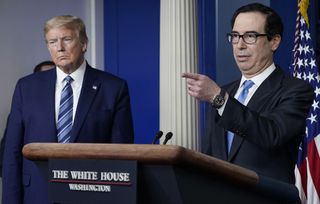Stimulus check 2 in doubt? Here's where each side stands
With stimulus check 2 talks stalled, Treasury Secretary calls for compromise.

Stimulus plan negotiations between Democrats and the White House have been on hold since Friday, and with neither side committed to restarting talks, Americans may be waiting longer than they may have hoped for a stimulus check 2.
Lawmakers and Trump administration representatives are trying to close the gap between the Senate Republicans’ $1 trillion HEALS Act introduced earlier this month and the House Democrats’ $3.4 trillion HEROES Act passed in May.
- The latest stimulus check 2 update
- Scientists develop coronavirus-killing nasal spray
- Just in: Stimulus check 2 could pass while Senate is on recess
At issue are ongoing federal unemployment benefits, which expired on July 31, as well as the total cost of the relief package.
Treasury Secretary Steven Mnuchin on Wednesday urged Democrats to restart talks after stating earlier this week that the administration is willing to commit more money to relief (a move that could face pushback from Senate Republicans).
Meanwhile, House Speaker Nancy Pelosi (D-CA) said the two sides are “miles apart” from an agreement.
“It’s a chasm, because they do not share our values,” Pelosi told MSNBC.
Neither side has offered a timeline to continue negotiations. Both House and Senate lawmakers are away from Washington until early September, with the possibility of returning only for a vote. But, if a bill is passed, the stimulus check 2 date could happen in a week.
Sign up to get the BEST of Tom’s Guide direct to your inbox.
Upgrade your life with a daily dose of the biggest tech news, lifestyle hacks and our curated analysis. Be the first to know about cutting-edge gadgets and the hottest deals.
Unemployment benefits vs. stimulus check 2
All parties agree on the need for stimulus check 2, so if a larger relief bill does pass, it’s likely that eligible Americans will get a second $1,200 payment.
There are slight differences across proposals over what stimulus check 2 eligibility would look like (adult dependents, for example), but a second direct payment has wide support.
There's even a stimulus check 2 calculator you can use to find out how much money you could qualify for.
Continued federal unemployment benefits aren’t as clear-cut, however. House Democrats want to continue the $600-per-week program for the foreseeable future, while several Senate Republican proposals would reduce the weekly amount immediately and phase out enhanced federal payments over two to four months, with states picking up the slack.
Over the weekend, President Trump signed an executive order that would continue benefits at $400 a week for the rest of the year, though it’s unclear how this would work in practice.
Ongoing spending on the federal supplement is a particular sticking point in the stimulus package negotiations.
Emily Long is a Utah-based freelance writer who covers consumer technology, privacy and personal finance for Tom's Guide. She has been reporting and writing for nearly 10 years, and her work has appeared in Wirecutter, Lifehacker, NBC BETTER and CN Traveler, among others. When she's not working, you can find her trail running, teaching and practicing yoga, or studying for grad school — all fueled by coffee, obviously.

